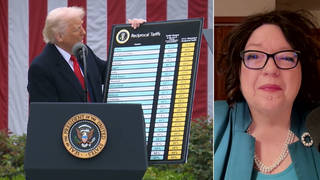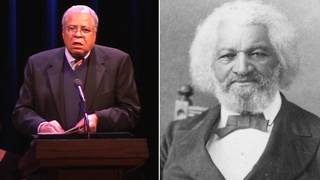
Guests
- Ta-Nehisi Coatesis a national correspondent at The Atlantic, where he writes about culture, politics and social issues. He has just written a cover story for the magazine called “The Case for Reparations.” Coates is also the author of the memoir The Beautiful Struggle.
We air part two of our interview with famed essayist Ta-Nehisi Coates about his cover article in The Atlantic, “The Case for Reparations,” in which he exposes how slavery, Jim Crow segregation and federally backed housing policy have systematically robbed African Americans of their possessions and prevented them from accruing intergenerational wealth. “It puts a lie to the myth that African Americans who act right, who are respectable, are somehow therefore immune to the plunder that is symptomatic of white supremacy in this country,” Coates says. “It does not matter. There’s no bettering yourself that will get you out of this.”
Transcript
JUAN GONZÁLEZ: We end today’s show with the second part of our interview with famed essayist Ta-Nehisi Coates talking about his explosive new essay, “The Case for Reparations.” The 16,000-word article is the cover story for the June issue of The Atlantic magazine and is being credited for rekindling a national discussion on reparations for American slavery and for institutional racism.
AMY GOODMAN: In the piece, Ta-Nehisi Coates exposes how slavery, Jim Crow segregation and federally backed housing policy systematically robbed African Americans of their possessions and prevented them from accruing intergenerational wealth. Much of it focuses on predatory lending schemes that bilked potential African-American homeowners. Juan González and I interviewed Ta-Nehisi Coates on Thursday. For the first part of our conversation, go to democracynow.org. This is part two.
JUAN GONZÁLEZ: One of the things that you mention in that article, that—when people speak about racism or white supremacy in this country, they’re usually talking about individual acts or, for instance, Donald Sterling and the Los Angeles Clippers, his remarks have gotten widespread attention. But they don’t want to talk about any of the institutional manifestations of racism. You write, quote, “It’s very hard to accept white supremacy as a structure erected by actual people, as a choice, as an interest, as opposed to a momentary bout of insanity.”
TA-NEHISI COATES: Right, right, right.
JUAN GONZÁLEZ: Could you expound on that?
TA-NEHISI COATES: Well, you know, again, I mean, this goes back to one of the things I was saying earlier. I mean, we have this—our notion of racism, as you mentioned, is, you know, Donald Sterling, Cliven Bundy. You know, somebody says something that seems intemperate. We think of racism as, you know, a matter of the heart. And this is like one of the reasons why it becomes so explosive, say, today, to call somebody, quote-unquote, “racist,” because you basically are calling them a child molester or something like that. But the statements of individuals are largely more symptomatic than they are the source of anything.
The thing people have to remember is there’s nothing natural about racism as it exists in America. I mean, we know this historically. We can look at 1619, when Africans first came here, and how early African slaves intermixed pretty discriminately with indentured white servants. You know, you can look at Bacon’s Rebellion, where you see black people and poor white people actually allying in a rebellion. A hundred years later, for some reason, that would not happen. And we can see why that would not happen if you look at the actual laws. What we call black in America today is a matter of laws, laws that were actually passed to enforce slavery. What we call black here today is not what, you know, folks call black in Brazil. It’s not necessarily what—you know, even what people would call black in Louisiana a hundred years ago. Things change. You know, race is the actual manifestation of a done thing, and that has profound, profound consequences. And I think if we can focus on that, if we can understand it as a structural thing, you know, as a matter of actual policies, as opposed to some intemperate remarks somebody made as a result of those policies, I think we would be in a much better place.
AMY GOODMAN: One of the people you write about is Ethel Weatherspoon. She has owned her own home in the North Lawndale neighborhood of Chicago for more than half a century. In a video accompanying your piece, Ethel Weatherspoon explains how she bought her house on contract.
ETHEL WEATHERSPOON: I moved in his house in 1957. It was mostly a white area. And when they said that the niggers was coming, they didn’t say black, they said the niggers was coming. And they start—just start moving away. Mostly everyone that was black, they had been sold a contract. If you missed a payment in three months, they could take the property back. No lawyer, no nothing could help you. That was it.
AMY GOODMAN: Talk about Ethel Weatherspoon and this—what you talk about as institutional racism, Ta-Nehisi Coates—
TA-NEHISI COATES: I would love to.
AMY GOODMAN: —and what happens in housing.
TA-NEHISI COATES: Yeah, gladly. Everybody asks me about Mr. Ross; I’m so happy to be able to talk about Mrs. Weatherspoon. You know, I wanted to include her story because I think, again, when we talk about African Americans who live in neighborhoods like North Lawndale, there’s a kind of traditional narrative out there: You know, these folks have fallen into cultural pathologies; if they would just get married and act right, everything would be OK. Well, Mrs. Weatherspoon was married for many, many years, had kids. Her kids are doing well. She’s a homeowner, you know, is a very, very responsible citizen of Chicago. And yet she lives in North Lawndale, a neighborhood that just in terms of any sort of socioeconomic indicator is on the wrong end in terms of Chicago.
You know, one of the most provocative things about her story and, you know, how she came up and just how much work that she put in, and then the fact that she was able to hold on to her home in that situation, is it really puts a lie to the myth that African Americans who act right, who are respectable, you know, are somehow therefore immune to the plunder that is symptomatic of white supremacy in this country. It does not matter. There is no, you know, bettering yourself that will get you out of this. There’s no sort of immunity for black people who get married or black people who go to church every Sunday or black people who hold jobs. The people who I profile in this article are some of the most hard-working Americans that you would ever want to meet, and yet they were exploited anyway.
JUAN GONZÁLEZ: I wanted to ask you, throughout the 1950s and the 1960s, the federal government basically helped to finance the main wealth gathering of most Americans—
TA-NEHISI COATES: That’s right.
JUAN GONZÁLEZ: —through FHA mortgages, and that built the suburbs, really, of most American cities. Talk about that as a federal policy that—and why it basically did not work in terms of African Americans.
TA-NEHISI COATES: Well, you know, one of the problems that we have—and I think this goes beyond, you know, a discussion of white supremacy and racism, but the myth of rugged individualism in this country, as though people just walked out to the suburbs, planted stakes, and then the suburbs just sort of bloomed from nowhere. The suburbs are federal policy. In the 1930s and the 1940s, we set up the FHA. We set up the Home Owners’ Loan Corporation. We set up specific bureaus to make our communities look the way they look.
In 1995, I took a trip to Chicago, my first time as an adult, and I was writing down the Dan Ryan Expressway, and at that time there was the longest row of projects, public housing, I think, in North America along that corridor. And it struck me as a moral disaster. What I did not understand at that time was this was actually planned, that African Americans had been cut out of any sort of legitimate housing program during the ’30s, ’40s, ’50s. And instead what we got was public housing built on a segregated basis, you know, at that point, in that particular case, on the South Side of Chicago.
There’s no way to understand housing as it exists today without federal policy. Black people, as was the thinking at the time, could not be responsible home loaners. The FHA literally drew up the redlining map and then basically distributed—I’m sorry, the Home Owners’ Loan Corporation actually did it, and then distributed to banks who used that as policy to determine how they would lend and who they would lend to. The racism in the system was pervasive and total. And the fact that African Americans have been cut out of it is not shocking if you understand what the country was in the 1930s and the 1940s. And this redounds throughout generations. As we know, homes are how people in America build wealth, largely. And if you cut black people out of that opportunity, a lot is explained about what the African-American community looks like today.
AMY GOODMAN: Ta-Nehisi Coates, you write in this remarkable piece, “The Case for Reparations,” “When progressives wish to express their disappointment with Barack Obama, they point to the accomplishments of Franklin Roosevelt. But these progressives rarely note that Roosevelt’s New Deal, much like the democracy that produced it, rested on the foundation of Jim Crow.” Talk about what you mean. You’ve been talking about housing, but also Social Security, GI benefits, and how they have failed African Americans.
TA-NEHISI COATES: Well, you know, the sad truth—I mean, like, you know, my politics are pretty obvious. Like any other progressive or any other liberal, you know, for years, I was particularly proud of the Roosevelt era and, you know, would often look back nostalgically at the GI Bill, at Social Security, at basically the erection of the safety net in America.
But when you look at actually how that was built—Ira Katznelson, a professor of Columbia, has done great work on this in his book When Affirmative Action was White and his newest book, Fear Itself. And what he basically shows is the way that was made possible was an alliance between Northern Democrats and Southern Democrats. And Southern Democrats had no problem with erecting a social safety net as long as it could be one that would benefit whites and would not upset white supremacy or the Southern way of life, as they put it at the time. And Democrats, you know, in the North wanting a deal—some of them racist, some of them not—were willing to go along with that, regrettably.
Social Security, I believe, as it was written at the time, you know, you couldn’t just outright say, “Black people can’t get this.” But what they did was they excluded domestic workers and agricultural workers. In the South, that was a broad swath of African Americans. So, when Social Security is first passed, it excludes something like 65 percent of all African Americans in the country, 80 percent of all African Americans in the South. And policy was designed in such a way it was filtered to the state level. In the case of GI Bill, where African Americans in the South, if you were a veteran, would then have to go deal with some Southern Veteran Affairs officer, and you can just imagine about how well you would fare in that case.
JUAN GONZÁLEZ: I wanted to ask you about the role of the contemporary banks. We now know, from a lot of reports that have come out recently, that one of the biggest banks in the country, Wells Fargo, had an emerging markets unit that specifically targeted black churches and the black communities for predatory loans. But now as the government is trying to make settlements with a lot of these banks, there doesn’t seem to be a targeted compensation to those who were most victimized, just a general sense that the banks will pay a certain amount of money to escape prosecution.
TA-NEHISI COATES: Right, right, right, right, right. And, you know, there was the class action suit which I think does some of that. But my greater concern is that the root problem of this, which is segregation—Wells Fargo had a marketing incentive to do what they did. And a marketing incentive was created by us many years ago and is here, you know, even today. It’s not a mistake. You know, they were able to get the memos. And in the memos you see them describing their customers as “mud people,” black people as “mud people,” describing the loans as “ghetto loans.”
The important thing to remember about this is—and this is what was proven in the research—even after you balance for credit worthiness, even after you balance for income, even after you balance for wealth, African Americans were still targeted. It was not just a matter of them being poor, being working-class, or whatever, and therefore being that; it was specifically because they were black. And, you know, again, that makes sense if you understand segregation, and you have this population of people right here.
Basically, our housing policies of the past made the plunder of today efficient. It made it efficient to go to black communities and plunder black communities through these predatory loans. And there’s no policy, even today, to break up that segregation, to make it inefficient. There’s no new policy to guarantee that 20 years from now this won’t happen again. And I think that’s really where the call for reparations really comes in. What are we going to do to make sure that this doesn’t happen again?
AMY GOODMAN: Ta-Nehisi, interestingly, you write that a black family that may make $100,000 typically lives in a neighborhood of white families making $30,000.
TA-NEHISI COATES: Yeah, and I think, like, you know, many times pundits, intellectuals, writers will try to do things like they’ll look at a black family, and they’ll try to control for income, or even, you know, often control for wealth. And there’s a great deal of sociology going on right now that demonstrates what’s called the “neighborhood effect.” And that means that it doesn’t make sense to actually look at an African-American family or a white family in isolation. You know, people largely reflect the communities that they live in. And again, because of our housing policies, because of our housing policies, increasing income for African Americans, you know, just—that isn’t enough. You have to be able to then take that income and invest it somewhere—in a house, in this case—and actually hope to have some return. African Americans are uniquely trapped in particular neighborhoods in this country. Those neighborhoods tend to be neighborhoods that are higher poverty, you know, when you look at their income and compare it to white income, and therefore suffer all the ills that impoverished neighborhoods suffer. When you see a stat like that—you know, a family making $100,000 is basically living in a neighborhood condition of $30,000—it really clarifies a lot.
JUAN GONZÁLEZ: And could you talk about how reparations might work in practical terms here in the United States?
TA-NEHISI COATES: Yeah, you know, there are many schemes out there right now. The most obvious one is just mail a check to Africans. Just figure out, calculate a number, you know, divide it by the number of African Americans, mail a check. That’s often joked about. I’m not prepared to dismiss that out of hand. You know, maybe that will be the right thing. Professor Charles Ogletree up at Harvard envisions something a little bit more systemic and a little bit more widespread, and that is a reinvigoration of the idea of erecting a stronger social safety net, policies that may not even necessarily just benefit African Americans, but policies that, you know, may disproportionately benefit African Americans, but with a strong social justice, a strong anti-racism rhetoric attached to it. I think, should we ever live in a world where there were reparations, what you would likely see is some sort of mix of the two. You likely would see some sort of targeted policy at African Americans along with some broader policies also.
But I think the rhetorical point of understanding, you know, that this is part of an ancient debt that we’ve incurred, I think, is really, really important. Just one brief example if I may. President Obama, when people wanted to criticize the Affordable Care Act, they would often say, “This is reparations, this is reparations,” and liberals were often caught in this cross of saying, “No, no, no, no, no, this isn’t for black people; this will benefit everybody.” In a just world, we would say, “Yes, this does disproportionately benefit black people, and that’s a very, very good thing, because for most of our history we’ve disproportionately injured black people, and our policies should be structured in such a way that take that into account.”
AMY GOODMAN: You know, interestingly, Ta-Nehisi, in the first part of our conversation, when you explained the part of your piece in “The Case for Reparations” about how Germany has given reparations to Israel, it’s not only the state of Israel. Germany had to make reparations, billions of dollars, to Holocaust survivors—
TA-NEHISI COATES: Mm-hmm, right, right.
AMY GOODMAN: —individually, wherever they lived, and there were many in the United States. But I wanted to ask you—you have not always been for reparations. What changed your mind? And talk about what surprised you most in doing this massive piece that you did for The Atlantic.
TA-NEHISI COATES: Well, you know, two things changed my mind. The biggest thing is just understanding more. And that’s the first thing. I guess that covers both things. The first thing is to understand America isn’t a country that just had a little bit of slavery. You know, slavery is not, say, ancillary to understanding American history. You actually can’t understand American history without understanding slavery. And that really became clarified for me as I begin to do my research and begin to do my understanding.
And just to clarify what I mean by that, in 1860, when we launch into the deadliest war in our history, 60 percent of our profits are derived from cotton. Slaves, as a whole—and I hate to talk about it that way, but slaves, as a whole, comprised the largest individual particular asset in all of America at the time of the Civil War. The region with the largest per capita millionaires in the country was the Mississippi Valley. When you talk about a source of wealth of that level, you know, you’re talking about a big, big, big, big, big piece of American history and a big, big piece of how we became America itself. So, understanding that slavery was itself not ancillary, but was central to understanding what America was, and then understanding what policies we passed in the 100 years after that, that reflected that ghost, that continued to injure African Americans, a lot of things became clear to me.
JUAN GONZÁLEZ: And your judgment, at this stage in the presidency of Barack Obama, our first African-American president, his willingness to tackle some of these issues, the ramifications of which and the theory behind which he clearly understands?
TA-NEHISI COATES: Yes, yes, yes, yes. You know, and I was—you know, it’s funny, I published the pitch note when I was first putting this together, and at the time, you know, I was saying, “Well, maybe Barack Obama should say something about this.” I’ve since changed my mind. I don’t think he should say absolutely anything about it. You know, I think the president is in a very unique position as the first African-American president. I think that shrinks the amount of things he can and can’t say. That does not mean, you know, that one should not be critical. I’ve definitely been critical. I think some of his rhetoric around culture and the culture of polity is deeply, deeply misguided and is erroneous and wrong. You know, having said that, it’s not my expectation that President Obama will come out tomorrow in support of reparations.
And I don’t even think that’s the way it should work. My hope, if anything—if anything, my hope would be that, A, other writers will take this on, and they won’t just look at it from a housing perspective. My hope is that they’ll look at it from a criminal justice perspective, which is another way think this article could be written, from an education perspective, from a healthcare. There are all sorts of ways that you could look at the dynamic of reparations. And then, after that, then we’ll have some sort of groundswell in the country that will build up a movement. Politicians respond to pressure, and I think that that’s what needs to happen. This is a long, long fight. This is not something that is supposed to be won next year, or even, you know, before Barack Obama leaves office.
AMY GOODMAN: Ta-Nehisi Coates. We’ll link to the cover story for The Atlantic called “The Case for Reparations,” as well as part one of our interview with him at democracynow.org.












Media Options